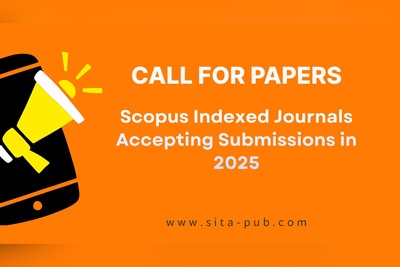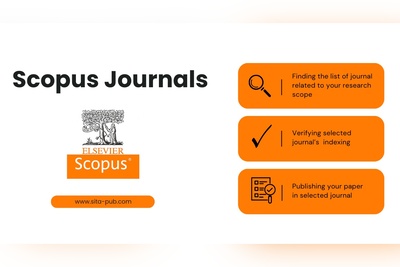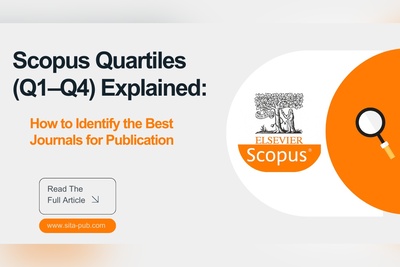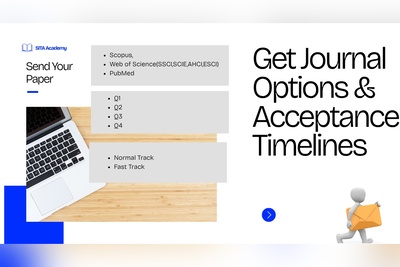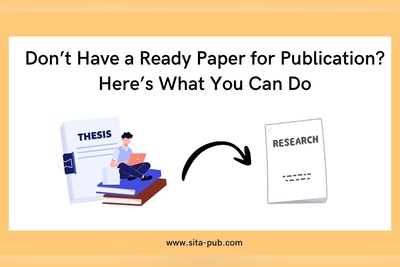From Thesis to Journal Article: How to Convert Your Dissertation into a Publishable Paper
Your thesis holds valuable findings—why not share them with the world? Learn how to convert your dissertation into focused journal articles and publish in international platforms like Scopus, ISI, and PubMed.

Publishing your findings in credible scientific journals is a crucial way to progress professionally and share your discoveries with the academic community. Many people wonder how to turn their Master’s or PhD thesis into one or more journal articles. While your thesis has a lot of valuable work, you can’t just submit it as is because journal articles have different rules and formats. This article will explain the main differences between theses and journal papers, why you can’t submit your thesis directly, and how to turn your research into publishable articles.
Thesis vs. Journal Articles: Understanding the Differences

To begin, it is essential to clarify the differences between a thesis or dissertation and a journal article. Although both are scholarly works, their purpose, audience, structure, and content vary significantly. Understanding these differences will help you appreciate why direct submission of a thesis is rarely possible and how to adapt your research accordingly.
Aspect | Thesis / Dissertation | Journal Article |
Purpose | To demonstrate comprehensive research skills and knowledge in a field; often required for degree completion. | To communicate key findings and contributions succinctly to the academic community. |
Length | Typically 100+ pages; can be several hundred pages long. | Usually 3,000 to 8,000 words, depending on journal. |
Structure | Includes Introduction, Literature Review, Methodology, Data, Analysis, Discussion, Conclusion, Extensive References, Appendices. | Focused Introduction, Brief Literature Review, Methods, Results, Discussion, Concise References. |
Content Detail | Very detailed background, extensive literature review, and full explanation of methods and data. | Emphasis on concise, clear presentation of results and main discussion points. |
Audience | Committee members, examiners, and academic supervisors. | Broad scientific community and researchers in the field. |
Review Process | Internal academic examination. | External peer review, often double-blind. |
Purpose of Writing | To fulfill academic degree requirements. | To share novel findings and contribute to ongoing research discourse. |
Publication Venues | Usually archived in university libraries, institutional repositories, and theses databases such as ProQuest Dissertations & Theses. | Published in indexed scientific journals included in databases like Scopus, Web of Science (WoS), PubMed, and others. |
Why Can’t You Submit Your Thesis Directly to a Journal?
It might seem tempting to submit your thesis or dissertation as-is to a journal to save time and effort, but journals generally do not accept theses in their original form for several reasons:
Length and Detail: Theses are very long and detailed documents. Journals require manuscripts to be concise and focused, with strict word limits that make it impossible to include every detail from your thesis.
Writing Style: Theses have a comprehensive and sometimes repetitive narrative style aimed at demonstrating a deep understanding of the topic. Journal articles, by contrast, demand clear and succinct writing that highlights key findings without unnecessary elaboration.
Content Overlap: Theses include extensive literature reviews and methodology sections that journals expect to be summarized or referenced to keep the article concise.
Multiple Publications: Most theses contain enough material for multiple journal articles. Submitting the entire thesis as one paper is not only impractical but also limits your potential number of publications.
Formatting and Guidelines: Each journal has strict formatting and stylistic guidelines regarding citations, figures, tables, and structure, which differ greatly from those of theses.
Audience and Focus: Journals target a broad, international scientific audience interested in the novelty and impact of the findings. Theses cater mainly to a university committee.
How to Convert Your Dissertation into a Publishable Paper
The process of turning your thesis into publishable journal articles involves a clear, step-by-step strategy:
Identify Key Research Questions or Findings:
Review your thesis carefully to pinpoint the most important and original contributions. These should form the basis of your articles. Ask yourself: Which parts of my research provide new insights or valuable data to the field?
Divide Content Logically:
Break down your thesis into distinct topics or themes. Each article should focus on a specific research question, dataset, or analysis. This segmentation allows for clearer, more targeted papers.
Simplify and Condense:
Rewrite the content for journal readership by reducing lengthy background information and detailed methodological descriptions. Focus on the core results, analysis, and implications. Use clear, direct language and avoid jargon.
Adapt Language and Style:
Adjust your writing style to be concise and reader-friendly. Most journals prefer active voice and straightforward expressions. Also, tailor your manuscript to fit the journal’s guidelines for tone and format.
Select Target Journals:
Choose journals whose scope aligns with the content of each article. Consider factors like the journal’s audience, impact factor, open access policies, and average review times. Selecting the right journal increases the chances of acceptance.
Prepare Submission Materials:
Follow the journal’s author guidelines meticulously. Prepare all required documents, such as cover letters, abstracts, graphical summaries, and conflict of interest declarations. Proper formatting is essential to avoid desk rejection.
How Many Papers Can You Extract from a Thesis?
The number of publishable articles that can be derived from a thesis varies, but typically ranges from two to five papers. This depends on:
The breadth and depth of your research: Broader theses with multiple experiments or case studies provide more material.
The number of distinct research questions or hypotheses addressed.
Your ability to narrow the focus of each article to highlight specific contributions.

For example, a thesis that includes experimental results, theoretical modeling, and case studies might yield separate papers on each. Conversely, a narrowly focused thesis might generate fewer articles but with deeper analysis.
Choosing Titles for Articles Extracted from Your Thesis
Selecting effective titles is a critical step in ensuring your articles gain attention and are easily discoverable:
Be Concise and Informative: The title should clearly indicate the main topic or finding without unnecessary words.
Include Keywords: Incorporate terms that potential readers or researchers are likely to search for online.
Make It Engaging: Avoid vague or overly technical titles. A well-crafted title should attract interest while accurately reflecting the paper’s content.

For instance, if your thesis chapter is titled “A Study of Environmental Effects on Plant Growth,” a journal article title might be “Impact of Soil pH on the Growth Rate of Tomato Plants Under Controlled Conditions.” The latter is more specific and keyword-rich.
Avoid simply reusing chapter titles from your thesis. Instead, tailor each title to the precise focus of the individual article.
The Importance of Title Selection on Publication Success
Your article’s title is the first impression editors and reviewers have—it plays a pivotal role in the publication process:
Searchability: Journals and databases rely heavily on keywords in titles for indexing. A clear, descriptive title improves the chances your paper will appear in relevant searches.
Editor’s Decision: Editors often scan titles when deciding whether to send a manuscript for peer review. A well-crafted title can increase the likelihood of positive consideration.
Reader Engagement: Catchy, informative titles attract more readers, downloads, and eventually citations, boosting your research’s impact.
Article Extraction from Thesis at SITA Academy
At SITA Academy, we specialize in transforming lengthy theses and dissertations into polished, publishable journal articles. We recognize the challenges researchers face when condensing comprehensive academic work into concise articles that meet strict journal requirements.
Our team has successfully helped many graduate students and researchers publish their research in international journals across various fields. We provide expert guidance and hands-on support through every stage of the article extraction and publication process, enabling you to focus on your research while we handle the technical and editorial complexities.
How the Article Extraction Process Works at SITA Academy

Our proven process ensures a smooth transition from thesis to journal article:
Send Your Thesis: Submit your full thesis or dissertation to our team for initial assessment.
Analysis and Proposal: Our experts analyze your research to determine how many articles can be extracted. We then propose potential article titles for each piece.
Approval: We share the proposed titles with you for review and feedback to ensure alignment with your research goals.
Article Development: After your approval, we begin rewriting and condensing the thesis content, tailoring each article to meet international journal standards.
Journal Selection: Upon completing the articles, we provide a carefully curated list of suitable journals for each paper, taking into account scope, impact, and processing time.
Publication Support: After your final approval, we assist with manuscript submission and guide you through the peer review and publication phases.
Language Isn’t a Barrier at SITA Academy
Worried your thesis isn’t in English? No problem. We have the expertise to extract and prepare English-language articles from theses written in Arabic, French, Russian, Turkish, and many other languages. Our multilingual team ensures your research reaches the international community without language barriers.
Ready to Publish?
Don’t let the complexities of converting your thesis into journal articles slow down your academic progress. Send your thesis to us (Below are our verified channels) for a thorough analysis and personalized plan. We will help you turn your dissertation into multiple, high-impact articles that meet the standards of top international journals.
With fast, professional, and effective support, you can confidently advance your academic career and share your valuable research with the global scientific community.
Verified Contact Channels
If you have any questions, inquiries, or would like to learn more about our services, please don't hesitate to reach out to us. Our dedicated team is ready to assist you.





